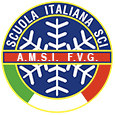Ski instructors: for learning and honing skills
According to the official definition, “instructors teach individuals or groups (on a temporary or permanent, exclusive or mixed basis) the techniques for all of the specialist types of skiing, using all types of equipment on ski slopes, ski trails, off-piste routes and tours with skis that do not involve difficulties requiring the use of climbing techniques and materials (such as ropes, axes and crampons).”
More simply, ski instructors are key figures for people who want to learn to ski or improve their skills. They can teach specific techniques while also motivating students, making the process fun, building up passion and helping them to overcome the uncertainty and the small degree of fear that are bound to crop up in the snow and the mountains due to their unique nature. Instructors do all of this while showing total respect for safety and the environment.
How to choose an instructor
Only choose qualified ski instructors!
Ski instructors are professional figures who must take specific courses and pass a number of exams in order to work in the field. In addition, every year they must do refresher courses so as to ensure that they are always fully qualified on the technical and educational fronts, not to mention in the extremely important field of safety.
Therefore, when you choose an instructor always make sure that he/she has the Italian Board of Ski Instructors and AMSI logos on his/her jacket: it is the only way to be certain that your instructor has all of the necessary qualifications and expertise.
The disciplines
Alpine skiing – also known as downhill skiing – is normally the way in which people first get into the sport. It is very popular with children, partly due to the playful way in which they are taught. Beginners first learn the “snowplough”, then move on to carving, which involves zig-zagging down the slopes (medium-turn skiing) and short radius turns (short-turn skiing). Well-equipped slopes with packed snow are used for Alpine skiing.
By definition, Nordic skiing encompasses all of the types of skiing in which it is not possible to attach the heels of the boots to the skis. They include cross-country skiing, biathlon, ski jumping, Nordic combined, ski touring, ski orienteering and telemark skiing. However, most of the time people use the term Nordic skiing to refer to the two main techniques of cross-country skiing: alternating foot to foot with the classic style and skating.
Snowboarding is a sport that first developed in the United States in the 1960s. There are three main styles: freeriding, freestyle and Alpine snowboarding. Freeriding is going downhill on fresh snow, while freestyle snowboarding nearly always takes place in snow parks or specially equipped areas, where jumps and tricks are performed. Alpine snowboarding is done on groomed pistes using directional boards that are stiffer than those chosen for other styles. Slalom courses are used for competitive events.

